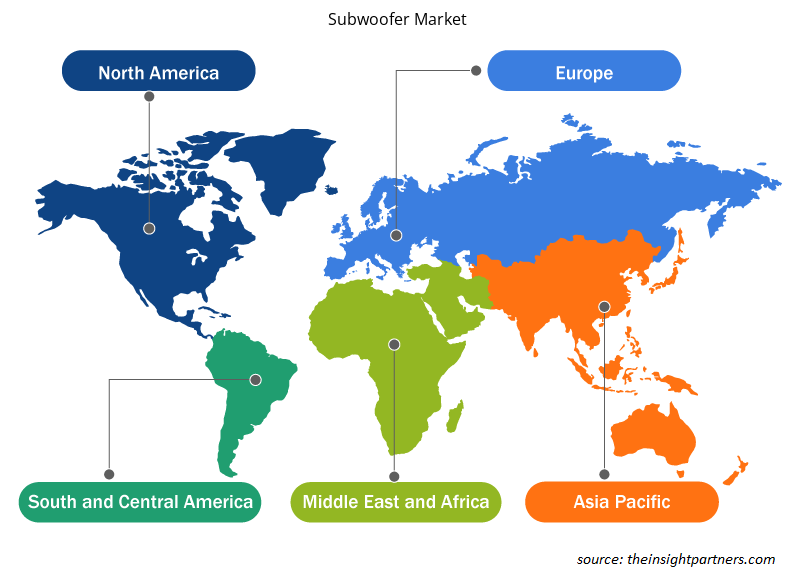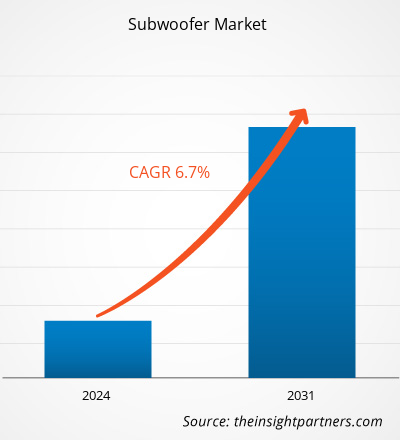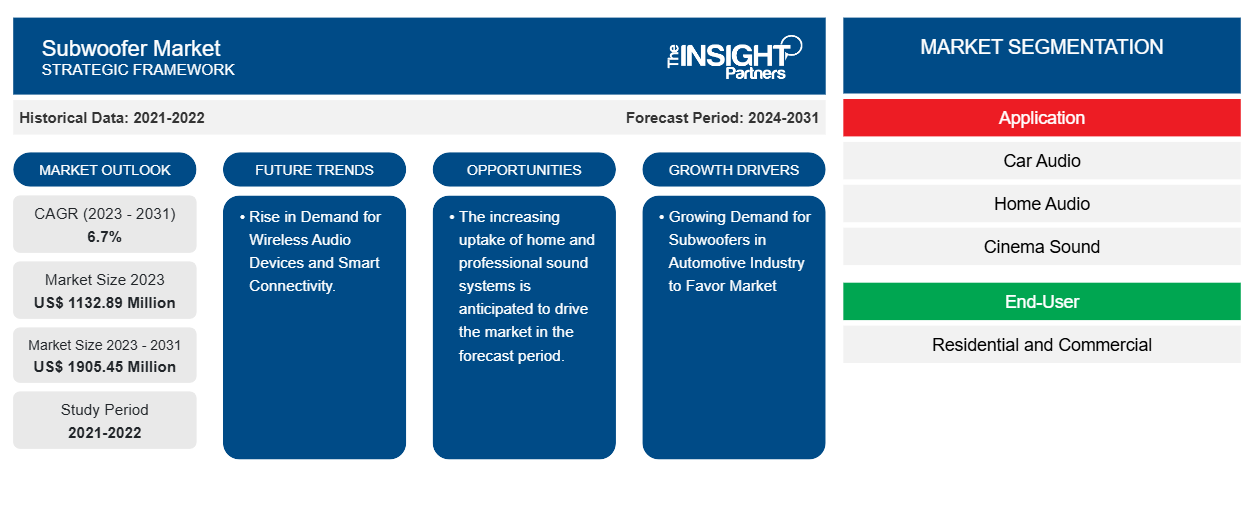Se prevé que el tamaño del mercado de subwoofers alcance los 1905,45 millones de dólares estadounidenses en 2031, frente a los 1132,89 millones de dólares estadounidenses en 2023. Se espera que el mercado registre una CAGR del 6,7 % durante el período 2023-2031. La creciente demanda en la industria automotriz y la creciente popularidad en aplicaciones residenciales para el hogar y en cines y teatros probablemente sean los impulsores y tendencias clave del mercado.
Análisis del mercado de subwoofers
El mercado de subwoofers está experimentando un crecimiento significativo a nivel mundial. Este crecimiento se atribuye a factores como la creciente demanda en la industria automotriz y la creciente popularidad en aplicaciones residenciales para el hogar y en cines y teatros. Además, se prevé que el aumento de la demanda de dispositivos de audio inalámbricos y conectividad inteligente y la creciente adopción de sistemas de sonido domésticos y profesionales brinden varias oportunidades para el mercado de subwoofers.
Descripción general del mercado de subwoofers
Un subwoofer es otra palabra para un altavoz y está dedicado a reproducir ese ritmo palpitante de baja frecuencia y graves intensos que puedes sentir en tus huesos en el club o durante una escena llena de acción en un cine. Los sonidos de baja frecuencia con la adición de un subwoofer incluyen canciones con graves intensos, bombos, una película retumbante, efectos de sonido de TV y más.
Personalice este informe según sus necesidades
Obtendrá personalización en cualquier informe, sin cargo, incluidas partes de este informe o análisis a nivel de país, paquete de datos de Excel, así como también grandes ofertas y descuentos para empresas emergentes y universidades.
-
Obtenga las principales tendencias clave del mercado de este informe.Esta muestra GRATUITA incluirá análisis de datos, desde tendencias del mercado hasta estimaciones y pronósticos.
Factores impulsores y oportunidades del mercado de subwoofers
La creciente demanda de subwoofers en la industria automotriz favorecerá el mercado
Un subwoofer completa la falta de graves de los altavoces principales del coche. El resultado es una experiencia auditiva más rica, viva y realista. Por eso, la reproducción de graves suele ser mucho mejor que la instalación original del vehículo. La mayoría de los altavoces estéreo de los coches empiezan a perder frecuencia alrededor de los 50 Hz. Pero un subwoofer de calidad reproducirá frecuencias bajas de hasta 20 Hz o menos.
Además, muchas empresas ofrecen subwoofers para automóviles. Por ejemplo, HARMAN International Industries lanzó la nueva serie Infinity Reference, una colección de subwoofers de montaje superficial. Con un buen diseño y diseñados para ofrecer graves potentes, los nuevos altavoces llevarán la experiencia de escucha en el automóvil a un nivel completamente nuevo.
Aumento de la demanda de dispositivos de audio inalámbricos y conectividad inteligente.
Se prevé que el aumento de la demanda de dispositivos de audio inalámbricos y conectividad inteligente genere varias oportunidades para el mercado. Los subwoofers que se integran perfectamente con los sistemas de audio inalámbricos son muy atractivos. A medida que los consumidores invierten en altavoces inalámbricos y sistemas de audio domésticos, aumenta la demanda de subwoofers compatibles. Además, está aumentando el número de empresas que ofrecen dispositivos de audio inalámbricos. Empresas como Boat, Zebronics, JBL, etc.
Análisis de segmentación del informe de mercado de subwoofers
Los segmentos clave que contribuyeron a la derivación del análisis del mercado de subwoofers son la aplicación y los usuarios finales.
- Según la aplicación, el mercado de subwoofers se divide en audio para automóviles, audio para el hogar, sonido de cine, refuerzo de sonido y otros. Se prevé que el segmento de audio para automóviles ocupe una cuota de mercado significativa en el período de pronóstico.
- Según los usuarios finales, el mercado de subwoofers se divide en residencial y comercial. Se prevé que el segmento residencial ocupe una cuota de mercado significativa en el período de pronóstico.
Análisis de la cuota de mercado de subwoofers por geografía
El alcance geográfico del informe del mercado de subwoofers se divide principalmente en cinco regiones: América del Norte, Asia Pacífico, Europa, Medio Oriente y África, y América del Sur y Central.
El mercado de subwoofers en América del Norte ha dominado. Las tendencias de adopción de alta tecnología en diversas industrias de la región de América del Norte han impulsado el crecimiento de este mercado. Se espera que factores como la mayor adopción de herramientas digitales, el alto gasto tecnológico por parte de las agencias gubernamentales, la creciente demanda en la industria automotriz y la creciente popularidad en aplicaciones residenciales para el hogar y en cines y teatros impulsen el crecimiento del mercado de subwoofers en América del Norte. Además, un fuerte énfasis en la investigación y el desarrollo en las economías desarrolladas de los EE. UU. y Canadá está obligando a los actores norteamericanos a traer soluciones tecnológicamente avanzadas al mercado. Además, los EE. UU. tienen una gran cantidad de actores del mercado de subwoofers que se han centrado cada vez más en el desarrollo de soluciones innovadoras. Todos estos factores contribuyen al crecimiento del mercado de subwoofers en la región.
Perspectivas regionales del mercado de subwoofers
Los analistas de Insight Partners explicaron en detalle las tendencias y los factores regionales que influyen en el mercado de subwoofers durante el período de pronóstico. Esta sección también analiza los segmentos y la geografía del mercado de subwoofers en América del Norte, Europa, Asia Pacífico, Oriente Medio y África, y América del Sur y Central.

- Obtenga los datos regionales específicos para el mercado de subwoofers
Alcance del informe de mercado de subwoofers
| Atributo del informe | Detalles |
|---|---|
| Tamaño del mercado en 2023 | US$ 1132,89 millones |
| Tamaño del mercado en 2031 | US$ 1905,45 millones |
| CAGR global (2023 - 2031) | 6,7% |
| Datos históricos | 2021-2022 |
| Período de pronóstico | 2024-2031 |
| Segmentos cubiertos |
Por aplicación
|
| Regiones y países cubiertos |
América del norte
|
| Líderes del mercado y perfiles de empresas clave |
|
Densidad de actores del mercado de subwoofers: comprensión de su impacto en la dinámica empresarial
El mercado de subwoofers está creciendo rápidamente, impulsado por la creciente demanda de los usuarios finales debido a factores como la evolución de las preferencias de los consumidores, los avances tecnológicos y una mayor conciencia de los beneficios del producto. A medida que aumenta la demanda, las empresas amplían sus ofertas, innovan para satisfacer las necesidades de los consumidores y aprovechan las tendencias emergentes, lo que impulsa aún más el crecimiento del mercado.
La densidad de actores del mercado se refiere a la distribución de las empresas o firmas que operan dentro de un mercado o industria en particular. Indica cuántos competidores (actores del mercado) están presentes en un espacio de mercado determinado en relación con su tamaño o valor total de mercado.
Las principales empresas que operan en el mercado de subwoofers son:
- Dynaudio A/S
- Matriz K
- Harman Internacional
- Corporación Sony
- Sonido SV
- Pioneer India Electrónica Pvt. Limitada.
Descargo de responsabilidad : Las empresas enumeradas anteriormente no están clasificadas en ningún orden particular.

- Obtenga una descripción general de los principales actores clave del mercado de subwoofers
Noticias y desarrollos recientes del mercado de subwoofers
El mercado de subwoofers se evalúa mediante la recopilación de datos cualitativos y cuantitativos a partir de investigaciones primarias y secundarias, que incluyen publicaciones corporativas importantes, datos de asociaciones y bases de datos. A continuación, se enumeran algunos de los avances en el mercado de subwoofers:
- Boult amplió su cartera de productos de audio con dos nuevas barras de sonido en India. La empresa ha anunciado su incursión en el audio doméstico inteligente con la presentación de las barras de sonido BassBox. Estos dispositivos pretenden revolucionar el entretenimiento en el hogar y prometen una experiencia de audio inigualable. (Fuente: sitio web de la empresa Boult, abril de 2024)
- HARMAN International Industries lanzó los subwoofers JBL CLUB e Infinity Reference. Los cuatro nuevos modelos combinan graves profundos y potentes con una eficiencia energética extrema para ofrecer un sonido excelente en cualquier sistema de audio del vehículo. (Fuente: sitio web de la empresa HARMAN International Industries, octubre de 2023)
Informe de mercado sobre subwoofers y resultados
El informe “Tamaño y pronóstico del mercado de subwoofers (2021-2031)” proporciona un análisis detallado del mercado que cubre las siguientes áreas:
- Tamaño del mercado de subwoofers y pronóstico a nivel global, regional y nacional para todos los segmentos clave del mercado cubiertos bajo el alcance.
- Tendencias del mercado de subwoofers, así como dinámica del mercado, como impulsores, restricciones y oportunidades clave.
- Análisis detallado PEST/Cinco fuerzas de Porter y FODA.
- Análisis del mercado de subwoofers que cubre las tendencias clave del mercado, el marco global y regional, los principales actores, las regulaciones y los desarrollos recientes del mercado.
- Análisis del panorama de la industria y la competencia que cubre la concentración del mercado, el análisis del mapa de calor, los actores destacados y los desarrollos recientes en el mercado de subwoofers.
- Perfiles detallados de empresas.
- Análisis histórico (2 años), año base, pronóstico (7 años) con CAGR
- Análisis PEST y FODA
- Tamaño del mercado, valor/volumen: global, regional y nacional
- Industria y panorama competitivo
- Conjunto de datos de Excel
Informes recientes
Testimonios
Razón para comprar
- Toma de decisiones informada
- Comprensión de la dinámica del mercado
- Análisis competitivo
- Información sobre clientes
- Pronósticos del mercado
- Mitigación de riesgos
- Planificación estratégica
- Justificación de la inversión
- Identificación de mercados emergentes
- Mejora de las estrategias de marketing
- Impulso de la eficiencia operativa
- Alineación con las tendencias regulatorias























 Obtenga una muestra gratuita para - Mercado de subwoofers
Obtenga una muestra gratuita para - Mercado de subwoofers